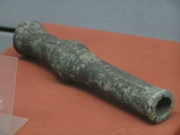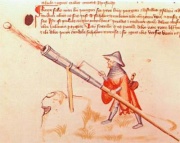Difference between revisions of "Hand cannon"
(New page: [[Hand cannon from the Chinese Yuan Dynasty (1271-1368).]] Western European [[handgun, 1380.]] [[Image...) |
m (1 revision) |
Revision as of 15:47, 15 March 2013

The hand cannon (Arabic: midfa; Chinese: 手銃), as it was called, was the first handheld portable firearm, or handgun.
Early firearms ranging from hand cannons to arquebuses are referred to in texts of the period by many spellings: gonne, gunne, canon being a few examples.
The hand cannon dates back to the late 13th century in Egypt and China, and was used until at least the 1520s in Europe and the Middle East, and until modern times in the Far East. However, where it was invented remains an area of controversy. The Arabs, Chinese and Mongols all have a claim - as do the Europeans. Archaeological evidence of a 13th century hand cannon excavated from Heilongjiang is backed by textual evidence from a rebellion in the year 1288, when the Christian Prince Nayan revolted against the Mongol ruler of China, Kublai Khan, the latter having his Jurchen commander Li Ting employ "gun-soldiers" or chongzu to suppress them.[1]
The hand cannon was a simple weapon, but effective in sieges and ambushes. It was less effective in open battle and in wet or windy conditions. Despite its crude appearance, the hand cannon could kill even armoured opponents at short ranges - if the gunner could manage to hit them. Experiments indicate an effective range of about 50 metres and a maximum range of about 300 metres, depending on calibre and type of powder used.
Hand cannon ranged in barrel length from 190 to 600 mm and from 12 to 36 mm in calibre. Approximate weights ranged from 1.5 kg to a monstrous 15 kg for some siege models. Barrels were typically short compared to later firearms and made from wrought iron or cast in bronze. For ease of handling, the barrels were often attached to a wooden stock. This was done in two ways: either by resting the barrel in a groove in the stock and securing it with metal bands, or by inserting the stock into a socket formed in the rear part of the barrel. Some gonnes merely had a metal rod formed as an extension to the rear of the barrel as a handle. For firing, the hand cannon could be held in two hands while an assistant applied ignition (such as hot coals or burning tinder) to the touch hole, or propped against something and set off by the gunner himself. Illustrations depict gunners holding the stock in the armpit, or over the shoulder like a modern bazooka to aim their weapon. During sieges, hand cannon were rested on the edges of walls, over the sides of armoured carts, or on forked rests hammered into the ground. Hooks are often found attached to the bottom of the barrel to support the gonne against stationary objects or to reduce the recoil.
Later hand cannon were made with a flash pan attached to the barrel, and a touch hole drilled through the side wall of the gonne instead of the top of the barrel. The flashpan had a leather cover, and later on a hinged metal lid fitted, to keep the priming powder dry until the moment of firing and to prevent premature firing. The invention of corned powder, the slow match, and the flash pan around 1400 led to the widespread adoption of gonnes, as those who used them were now no longer required to mix their powder on the spot, to stay close to a source of fire, or to avoid exposure to bad weather.
The reasons why firearms gradually came to dominate European warfare are clear. The advantages of the hand cannon were: low cost; easy mass production; the ability to be used by fairly poorly trained troops; and a measure of control over their manufacture (and especially the manufacture of ammunition - an important consideration in a medieval Europe wracked by rebellion). Its armor-penetration capability was among the superior points of the firearm: while arrows were somewhat effective against mail armor, they were not nearly as effective as bullets when it came to piercing plate armor. While the hand cannon could not match the accuracy or speed of fire of the longbow, gunners did not require the special training and continuous practice from childhood required of a good bowman. Crossbows had superior power and accuracy compared to early hand cannon, but were expensive to make, slow to reload and almost as poorly affected by wet weather as hand cannon.
"Hand cannon" is also a slang word which can be used to refer to a modern firearm of significant power but small size. Large caliber pistols, shortened or "sawed off" rifles and shotguns may sometimes be refered to as "hand cannons," though the weapon in question need not be unusual or exotic. The term may also simply refer to any hand-held firearm found to be large or powerful, as a hyperbole term.
References
- ↑ Needham, Joseph. (1986). Science and Civilization in China: Volume 5, Chemistry and Chemical Technology, Part 7, Military Technology; the Gunpowder Epic. Taipei: Caves Books. Pages 293–294.

